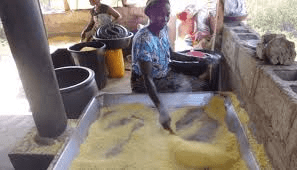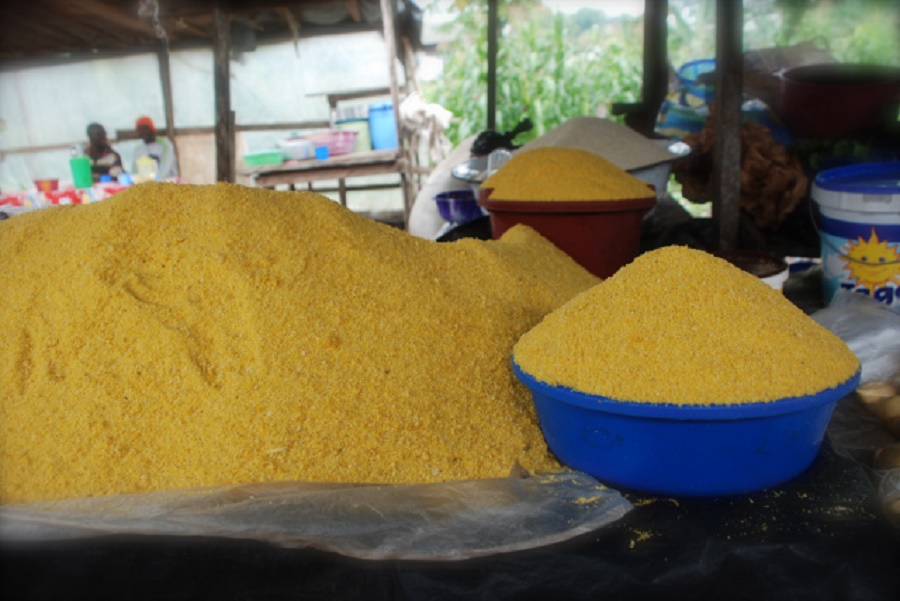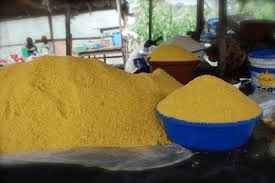Garri is processed from cassava tubers, and has become a much wanted staple food in Nigeria and some other parts of the world. Once considered to be food for the poor, garri is gradually slipping out of the reach of ordinary Nigerians who sometimes cannot do without helping themselves to a plate of eba (or garri flour mixed in hot water) or its soaked version every day.
Someone once shared with me that the businesses that will continue as long as human civilization remains are those businesses that meet the basic needs of man, i.e. food, clothing, health, and shelter.
There is a great sense in this. This is because as long as we are alive, we would require good and quality food, good clothing, good shelter and good health to lead an acceptable level of existence.
Nigerian communities must begin to look at developing businesses that can address these basic needs. This is why garri processing plant is one great business opportunity that fits this mould.
The industrial processing of cassava holds much potential for investors. Cassava can be processed into different products like garri flour, fufu, tapioca, ethanol, chips, starch, glucose syrup, etc.
All these products are in high demand locally and possess significant export potentials.
However, restricting your plant to processing only garri flour for sale can still achieve for you the status of a large, national and/or international business.
Read Also: Sowing Guide for Different kind of Crops
The Garri Staple Food

Garri is a creamy-white or yellow granular flour with a slightly fermented flavour and sometimes sour taste. It is made from fermented, gelatinised fresh cassava tubers.
According to an article thet was wrtten in 2015, Garri is a staple food largely eaten in Nigeria and other West African countries. Even in faraway America, Australia, Europe and some other parts of Africa, people eat this popular staple food with different delicious African soups.
The soaked version of garri flour taken with coconut, bean cakes (akara), beans pudding (moin-moin), groundnuts, or smoked fish, is another interesting delicacy for many people, especially when taken with cold water and during hot periods.
Some even prefer to add evaporated milk and sugar to enjoy their soaked garri.
Types of Garri Flour in the Market
The different types of garri flour in the market depend on the method of processing, grain size and the location of Africa where it is produced.
The choice of texture or size is to meet the specific use you want to put your garri to. While the fine or coarse grain garri is usually all right for eba, the extra coarse grain garri is usually soaked in water and eaten.
Garri is also classified based on the period of fermentation or whether palm oil is added to it.
The following are the different types of garri in the market:
(1) White Garri
This is the commonest form of garri found in most places in West Africa. It is fermented for two to three days without the addition of palm oil.
(2) Red Garri (which is actually yellow in colour)
This type of garri is commonly found in states like Edo, Delta and other Southern parts of Nigeria. It is also called Bendel garri.
It passes through the same preparation process like the white garri, only that red palm oil is added to give it that deep yellow colour.
The addition of palm oil helps to reduce the cyanide content and give it that unique colour.
(3) Ijebu Garri
This garri is made the same way the others are made, just that the fermentation is about 7 days. No palm oil is added.
It is fried to become crisped, is less starchy and has a very sharp taste. People from the Western part of Nigeria like this type of garri.
Read Also: The Different Nutrients Required by Crops at each Growth Stage
(4) Ghana garri
This garri is made in Ghana and the process is the same with the others just that the harvested and peeled cassava is soaked in water.
In the case of Ghana garri, after grating the peeled and soaked cassava, it is dried in the sun before it is fried to look and feel crispy.
Raw materials required for garri processing
The major raw material required in the production of garri is harvested cassava roots. The fresh cassava tuber should be free from microbial or insect damage.
It should also be processed within two days to prevent deterioration and loss of quality.
Machines and equipment for establishing a garri plant include a 5 HP capacity machine, which can produce five tons of grated cassava tubers.
You will also require a grating machine, hydraulic press, fryers, peelers/knives, wheelbarrow, basins, etc.
Garri Processing Method
The process of making garri is simple. It can be illustrated as follows: from cassava farm – peeling – grating/grinding – pressing – sieving – frying – cooling – bagging.
In other words, you collect the cassava tubers from the farm or suppliers, wash the tubers and clean them to remove sand and dirt; you peel the tubers with a knife or machine and then send the peeled tubers to the granulator where it is grated to a pulp.
The pressing process ensures that the cassava pulp is dewatered, removing its toxic elements and water. Then sieve before you fry. After this you bag your final product after frying and letting it cool. There you go; your garri product is finally out!
Read Also: History and Description of Cabbage
Market potentials of garri sales

The market potential for garri is huge and stable. Why? Everyday some African or Nigerian somewhere is consuming the garri product.
Garri flour products, especially eba and the soaked version, are consumed everyday from huts in the villages to mansions in the city. Your market includes everyone: students, workers, men, women, children, the elderly and so on.
The market value of garri products runs into billions of dollars every year. This market has continued to grow as many are converted to eating garri or making it part of their staple food.
The West African market, for instance, is close to 300 million people. Nigeria is about 170 million people and 75% fall into the effective demand bracket consuming at least a 5-litre bucket of garri flour every week.
If this 75% is a 5-member family, we are talking about (75% x 170,000,000=127.5 million/5=25.5 million families). If each family pays N400 for a 5-litre bucket of garri every week, then the market potential is 25.5 million times N400, which equals N10.2 billion worth of garri being consumed every week from our open markets.
If for any reason, 50% of this capacity is true, we are still talking about N5.1 billion worth of garri flour eaten every week.
Now tell me, doesn’t this business have a huge financial potential? It does!
Read Also: How to Start Cucumber Farming Business- (Beginners Guide)
How to start a garri processing plant
· Start-up cost is as low as N1 million or less depending on the size of investment
· Can be jointly carried out with other forms of businesses
· Potential first year earnings: From N2 million to almost a N100 million
· Breakeven time from initial investment: very rapid (can be between 1 to 5 years)
· Future growth potential: very high
· Dynamic, sustainable business
· Possible for Small business or Cooperative-based organizations
· Not much staffing required especially at the beginning
It’s high time our graduates and educated people considered getting into this kind of business so we can become self-sufficient in food production and processing, thereby creating jobs for many of our unemployed youths.
Read Also: 9 Impressive Health Benefits of Onions
Frequently Asked Questions
We will update this section soon.


I will like to know the cost of the machinery for garri processing, cost of getting the equipment to Nigera, factory yield or output range for different categories. The power consumption and water consumption of the machinery per tonne of processed cassava. Maintenance and servicing of machinery, procurement of replacement parts, training and after sales support.
Thanks
I will also like to know the cost of the machinery for garri processing from peeling to the finished line, cost of getting the equipment in Nigera. The power consumption and water consumption of the machinery per tonne of processed cassava. Maintenance and servicing of machinery, procurement of replacement parts, training and after sales support.